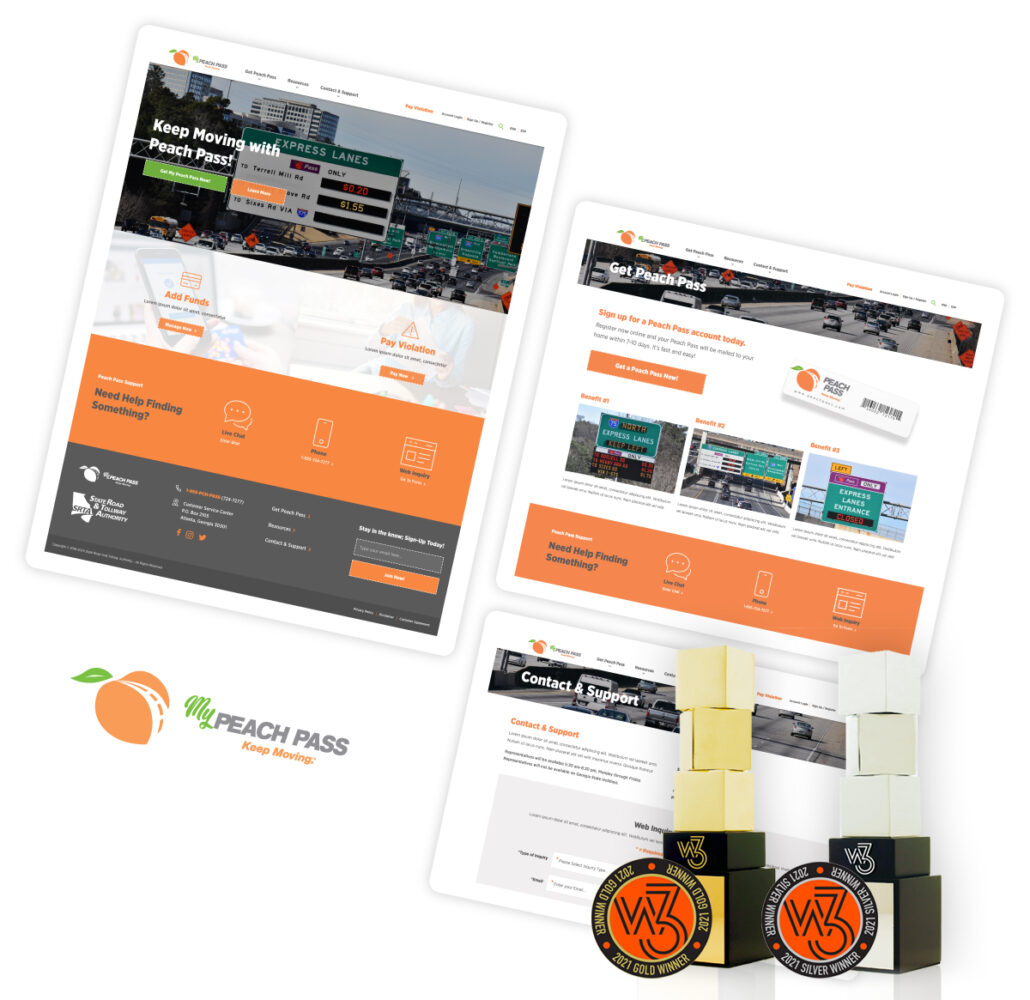How SRTA’s Focus on Users Led to An Increase in Happy Customers and a National Design Award
By Alexander Fakeri • November 1, 2021 •
By Alexander Fakeri • November 1, 2021 •
By Alexander Fakeri • November 1, 2021 • News,
Nothing says you’re doing things right like a testimonial from a client like Christopher Tomlinson – Executive Director of State Road and Tollway Authority in Atlanta Georgia.
In 2018 we had the opportunity to work with Chris and the State Road and Tollway Authority (SRTA) to develop an integrated enterprise website for Peach Pass – Georgia’s electronic toll collection system.
Before working with MOJO, the state of Georgia had made a significant investment in both physical and technological infrastructure for SRTA but users and customers were very unhappy with the experience they were receiving. This led to user frustration, a lack of Peach Pass registrations, and a decreased confidence in website users.
After working with MOJO, SRTA found that not only was user engagement improving and more drivers were registering but they also had gained significant savings in operational costs.
This was more than a website design project. It was the development of a web presence that would increase demand and flexibility to support SRTA’s rapidly growing population. Let’s dive into the full story.
At the time, SRTA’s website for the Peach Pass, mypeachpass.com, was leaving users dissatisfied. It was not user-friendly, and finding the right information was difficult. SRTA knew this was causing frustration for customers and potentially hurting their ability to register new drivers.
SRTA came to the determination that they needed a new public-facing website that would not only improve customer engagement but would integrate with their back-office and interact with the mobile app. Who they chose for the job would need to be seasoned professionals capable of handling such a robust project and who could understand the impact they wanted to make.
After much deliberation, SRTA trusted Kapsch Trafficom and MOJO to deliver the website experience they were looking for.
This was MOJO’s first state transportation contract opportunity to create a tolling website. Even though their experience in the tolling industry was minimal, the years of experience with web development, design, understanding user behavior and their unique implementation process gave them the confidence that they would succeed.
The creation of the updated mypeachpass.com website was segmented into 7 phases.
One important note to make is that MOJO did not have successful completion all on their own. Web design and development companies are great at creating the nuts and bolts of a website, but the voice has to come from the organization.
In order for the mypeachpass.com website to be successful, it would need input from those who knew its operations and users inside and out.
During the process, MOJO and SRTA came together as if they were one team. SRTA had the vision for what they wanted to achieve, and MOJO knew that they had to “get the creative” out of SRTA and bring to reality what they had in mind.
With great work done from all sides of the partnership, the implementation of the public-facing website was completed successfully.
As agreed, mojo delivered a public-facing website that interacted with both the mobile application, the state-wide transit authorities back-office systems, and infrastructure that supports over 2 million drivers. With MOJO, Kapsch and SRTA would roll the new website out to their customer base with less than a 1% error rate. Using Drupal the site was: mobile responsive, WCAG 2.1, 508 ADA Compliant, had the ability of Spanish translation and was capable of delivering data to Georgia Drivers with near real-time accuracy.

The best part of this story isn’t how well MOJO and SRTA were able to work together or that the process went smoothly, but rather, the impact from the new website. Here is what happened over the next several months:
At the end of the day, that’s what MOJO likes to see.
This wasn’t a story about a web development company helping a tolling authority cash in on more users. It was an example of what can happen when a tolling authority focuses on user experience and decides to do what’s best for its users and potential users.
At MOJO, we are just happy that we get to be part of the process of bridging the gap between tolling authorities and their users. Since our initial bid with SRTA we have become deeply entrenched in the tolling industry. We are active members of the IBTTA, we successfully launched a website for the Riverside Country Transportation Commission, and we will continue to partner with Kapsch TrafficCom to complete more projects. As an advocate of the tolling industry, we hope to continue bringing the best of both worlds to help improve the relationship between tolling authorities and the everyday driver.